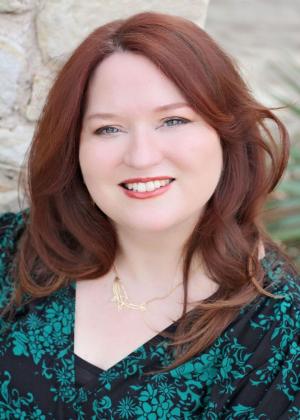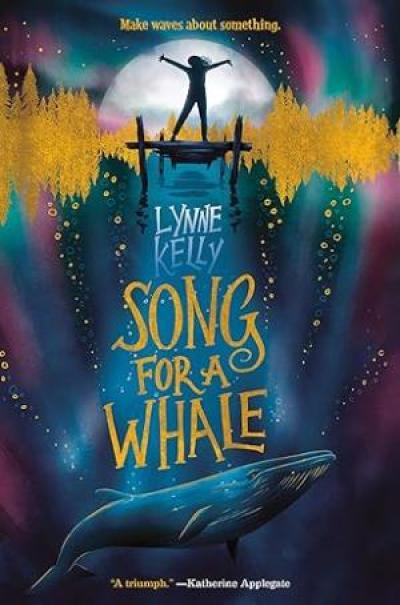 Before becoming a writer, Lynne Kelly was a teacher.
Before becoming a writer, Lynne Kelly was a teacher.
Ahead of her visit to Alliance, the author has a homework assignment for readers.
She urges them to come up with as many questions as they can for her when she appears at 7 p.m. Thursday, March 21 at the Brush Performance Hall inside the Giese Performing Arts Center on the campus of the University of Mount Union.
“I love answering readers’ questions, so I hope to have lots of Q&A time,” said Kelly, who penned Song for a Whale, the Carnation City’s 2024 One Book One Community selection. “I also like to talk about the idea-to-publication journey and show some behind-the-scenes things about the book, like character brainstorming, fun facts I picked up while researching, etc.”
Winner of the Schneider Family Book Prize, Song for a Whale is about Iris, a 12-year-old girl who is the only deaf person in her school. When she finds out about Blue 55, a whale who is unable to communicate with other whales, she sets out to create a song and get it to him to show that he is not alone. And she doesn’t mind breaking a few rules to accomplish her goal.
Here is a conversation with Kelly ahead of her visit:
Q: In Song for a Whale, you gave Iris a hobby that is associated with sound -- repairing radios.
A: Right, it's an unusual hobby! That was inspired by a college student I interpreted for. He’d always been interested in building and working with electronics, and started repairing old radios and TVs when he was a kid. It didn’t matter that he couldn’t hear the devices when they were working; he just enjoyed fixing electronics and he could figure out what needed to be done. I thought that was an interesting skill, and decided to give it to Iris. Those broken radios connected well with the whale who sings an unusual song, and it also shows readers that she's a smart and creative problem-solver.
Q: It can be difficult to communicate with adolescents. Throw in a language barrier such as Iris and her father have and that would make it so much harder.
A: Yes, it’s a challenge for so many families. Since most deafness is not hereditary, family members probably haven't interacted with other deaf people before finding out they have a deaf kid. Ideally, the parents start learning sign language, but it's surprisingly uncommon. I've known countless deaf people who can't communicate well with their hearing family members.
Q: You added a little humor into the story with the classmate who thinks she knows how to use ASL correctly, but was always getting things wrong. However, that character also illustrates how frustrating it would be for Iris.
A: Yes, poor annoying Nina! I've actually gotten to know her better since she’s the main character in my next novel, The Secret Language of Birds. I think she really wanted to be friends with Iris, but went about it the wrong way and instead ended up pushing her away. In addition to the isolation Iris experienced at school, it would be really frustrating to have the daily communication barrier and someone quite literally in her face not respecting her boundaries.
Q: You worked as an ASL interpreter. How did you become involved in that?
A: I'd planned to take just one sign language class as an elective in college, then enjoyed it so much, I took another class the following semester. That was all the college had at the time, but I wanted to continue learning more. I started taking community education classes taught by deaf people, and that’s where I learned the most. I did that for about a year and a half. By the time I graduated, I knew I wanted to pursue a career in something related to sign language. I still interpret, usually in college classes or public schools, along with the occasional medical appointment.
Q: What was the inspiration for Song for a Whale?
A: Finding out about the real-life “lonely whale!” I saw a post about the 52 hertz whale, whose song probably can’t be understood by other whales because of its unusually high frequency. Right away I started reading all the articles I could find about this whale, and couldn’t stop thinking about him. I think as writers we look for those ideas that don't let us go - that lets us know that others out there will probably connect to the story too.
Q: The story is a moving one in several ways for readers of all ages. What do you hope people come away with after reading the book?
A: I've been so pleased to see readers of all ages enjoying the story. Of course when the book was released in 2019, I had no idea that a year later, themes of communication and isolation would be much more relevant than before. Though Iris’ story is a unique one, I hope that readers will connect to those universal feelings she experiences and the need for community.
Q: Did you always want to be a writer?
A: No, like interpreting, that was something I stumbled into and fell in love with enough to do forever. I’ve always been a big reader, but writing a book was never something I’d considered. I was a special education teacher for third- through fifth-grade students when I got the idea for my first novel, Chained, about a captive elephant. At first, I was thinking it’d make an interesting story to tell my students, but later I wondered if could turn into something for a larger audience. I had a lot to learn about writing and publishing, but the book was published six years later. Though it took a lot of time and work and patience, I found that I liked taking an idea and turning into a story.
Q: There is more attention being paid to the Deaf community. What else should be done?
A: Probably the most important thing is to include deaf people in projects that have to do with them. Movies and TV shows are better now about casting deaf actors to play deaf characters, and hiring deaf consultants for sign language dialogue.
Learning some conversational sign language is easier than ever now, with the availability of online courses and ASL teachers on social media (just be sure to learn from deaf people to be sure you have a good language model!)
